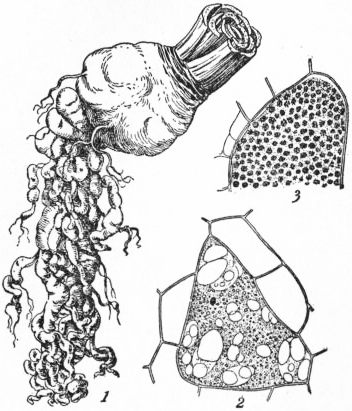Finger-And-Toe
 From Britannica 11th Edition (1911)
From Britannica 11th Edition (1911) Finger-And-Toe, Club Root or Anbury, a destructive plant-disease known botanically as Plasmodiophora Brassicae, which attacks cabbages, turnips, radishes and other cultivated and wild members of the order Cruciferae. It is one of the so-called Slime-fungi or Myxogastres. The presence of the disease is indicated by nodules or warty outgrowths on the root, which sometimes becomes much swollen and ultimately rots, emitting an unpleasant smell. The disease is contracted from spores present in the soil, which enter the root. The parasite develops within the living cells of the plant, forming a glairy mass of protoplasm known as the plasmodium, the form of which alters from time to time. The cells which have been attacked increase enormously in size and the disease spreads from cell to cell. Ultimately the plasmodium becomes resolved into numerous minute round spores which, on the decay of the root, are set free in the soil. A preventive is quicklime, the application of which destroys the spores in the soil. It is important that diseased plants should be burned, also that cruciferous weeds, such as shepherd’s purse, charlock, &c., should not be allowed to grow in places where plants of the same order are in cultivation.
 |
| Finger-and-Toe (Plasmodiophora Brassicae). |
|
1, Turnip attacked by the disease, reduced. 2, A cell of the tissue containing the plasmodium; the smaller cells at the sides are unaffected. 3, Infected cell, showing spore formation. 2, 3, highly magnified. |
↧ Download as ZWI file | Last modified: 11/17/2022 15:23:48 | 5 views
☰ Source: https://oldpedia.org/article/britannica11/Finger_and_Toe | License: Public domain in the USA. Project Gutenberg License
 ZWI signed:
ZWI signed: KSF
KSF